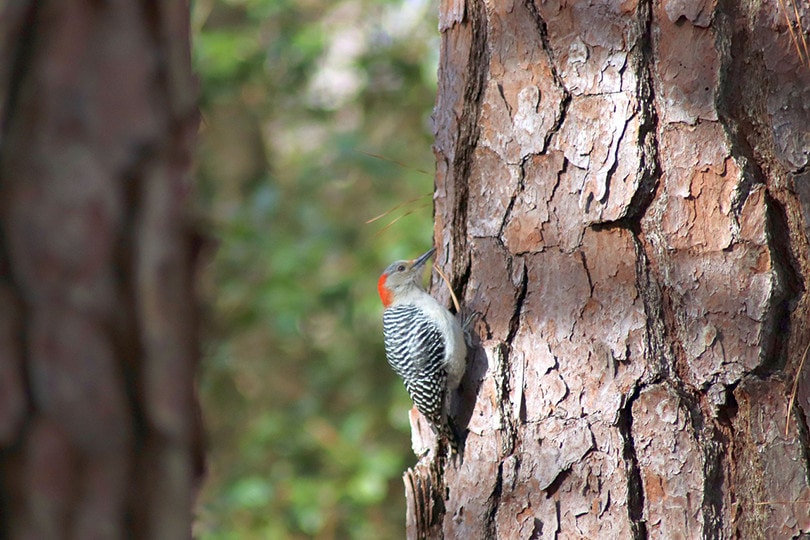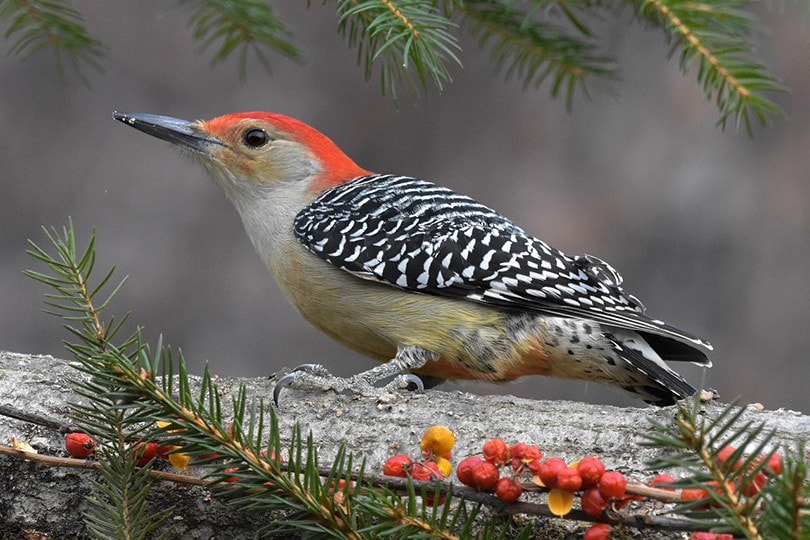Do Woodpeckers Eat Other Birds? What You Need To Know
Last Updated on

Woodpeckers are attractive and unusual birds with bright colors, bold markings, and vibrant personalities. But ask any birdwatcher “what do woodpeckers eat?” and there will be many different answers. The truth is, woodpeckers are primarily insectivorous and feast on insects they find in trees. These gorgeous birds also have an anatomical particularity that allows them to seek their favorite food in the crevices of trees: it is a long tongue with hairs. Thus, their salivary glands secrete a slimy, sticky substance that coats the tongue and makes it, together with the hairs, a formidable tool for catching insects.
But do woodpeckers use their formidable tongue to also devour other birds? Maybe, but that would only be a rare and seasonal feeding strategy.

Do Woodpeckers Eat Baby Birds?
Only some species, such as the Red-bellied and Red-headed woodpecker, may occasionally scavenge carcasses or carrion. Yet, in 2015, an ornithologist caught on camera a gruesome behavior never seen before: a Gila woodpecker feasting on a baby dove’s brain.
Fortunately, this behavior seems rather unusual, given the lack of reported cases in the scientific literature, although the Gila woodpecker has been known to eat bird eggs and occasional juicy pieces of meat.

What Do Woodpeckers Eat?
Rest assured, the main diet of woodpeckers does not consist of baby bird brains.
As mentioned earlier, woodpeckers are primarily insectivores. But depending on the season, a woodpecker can eat several different things. The exact foods preferred by each species vary, but the most popular foods for woodpeckers include:
- Insects, especially forest insects, grubs, spiders, and ants
- Tree sap
- Nuts
- Seeds
- Berries and fruits
- Flower nectar
Woodpeckers stay in the same range all year round, but as the seasons change, they change their diet to take advantage of readily available foods that meet their nutritional needs.
In spring and summer, woodpeckers feed on flying or hidden insects as they find them. Once the eggs hatch, they must find larger, easier-to-catch prey for their chicks, such as caterpillars, mayflies, and moths. In season, the woodpecker also feeds on wild berries.
After the nesting period, the woodpecker resumes its particular food habits. It stalks small insects and larvae that infest trees and hide in cracks and crevices of twigs and trunks.
In addition to varying their food choices depending on the season, some species have developed foraging strategies to conserve their food during the long winter months. The Acorn woodpecker, for example, stores hundreds of acorns in vast holes in dead trees. Other species go so far as to bury dead insects in the ground to retrieve them later, much like a dog burying its loot in the garden!

Do Woodpeckers Attack Other Birds?
Some species, like the Gila woodpecker, are more aggressive and may attack other birds, mainly during the nesting period. However, they do so to defend their territory and do not hunt other birds to eat them. But it is true that as foragers and opportunistic birds, woodpeckers find their food wherever they can, including in the nests of other birds.
How To Attract Woodpeckers to Your Garden
Apart from some species, woodpeckers are rather shy and prefer to stay away from the noise and activity of other birds. Also, since they eat large amounts of insects, including ants and beetles, they are welcome among gardeners. Here are some tips for attracting woodpeckers to your yard:
- Food: In addition to insects found naturally in your yard, woodpeckers will enjoy nuts, berries, and tree sap. They will also feed on suet, sunflower seeds, peanut butter, and even mealworms. You can also plant a few shrubs or trees that produce berries and nuts to provide an additional food source for the woodpeckers.
- Feeders: Choose vertical feeders so woodpeckers can come and eat comfortably. If possible, leave some dead tree trunks and old stumps to create a mini-ecosystem allowing the development of insect larvae, which will delight the woodpeckers!
- Water: These birds enjoy more secluded natural baths rather than bustling, noisy pedestals. Place a birdbath in a shady, quiet location so woodpeckers can bathe undisturbed.
- Shelter: Hardwoods and mature conifers (such as oaks and pines) provide perfect natural shelter for woodpeckers. If you are lucky enough to have a small, wooded area in your backyard, chances are you already have regular feathered visitors!

Conclusion
Most woodpeckers are rather shy and will not attack other birds unless they invade their territory. While it is true that some woodpecker species, such as the Gila, the Red-bellied and Red-headed woodpeckers, may eat bird eggs or carrion if other food resources are scarce, these behaviors are not common. So, don’t hesitate to attract these magnificent birds to your yard if you want to take advantage of their beauty and great skills as ruthless insect hunters!
Featured Image Credit: CoastalSandpiper, Pixabay
About the Author Robert Sparks
Robert’s obsession with all things optical started early in life, when his optician father would bring home prototypes for Robert to play with. Nowadays, Robert is dedicated to helping others find the right optics for their needs. His hobbies include astronomy, astrophysics, and model building. Originally from Newark, NJ, he resides in Santa Fe, New Mexico, where the nighttime skies are filled with glittering stars.
Related Articles:
What Is the Best Binocular Magnification for Hunting? Optical Features Explained
Can You Use Binoculars to Look At Stars? How to Choose the Right Pair
10 Types of Hummingbirds in Arkansas (With Pictures)
8 Types of Hummingbirds in Nebraska (With Pictures)
5 Types of Hummingbirds in Idaho (With Pictures)
3 Types of Hummingbirds in Mississippi (With Pictures)
8 Types of Hummingbirds in Kansas (With Pictures)
5 Types of Hummingbirds in West Virginia (With Pictures)
